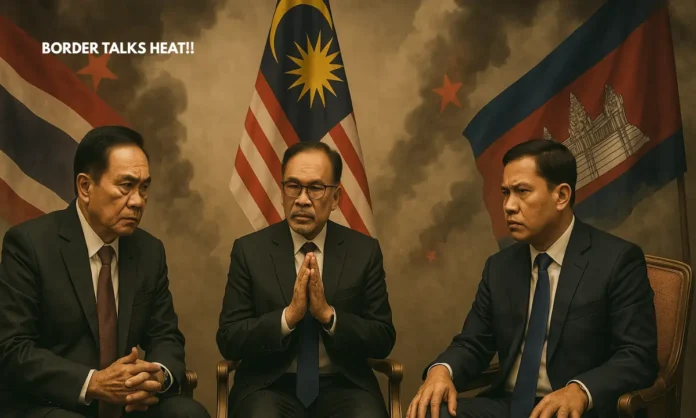Summary
- ASEAN-hosted talks aim to defuse the deadliest Thai-Cambodia clashes in over a decade.
- Donald Trump’s trade pressure forces both nations to consider a ceasefire.
- Over 30 deaths and 150,000 displaced underline the urgency of a diplomatic resolution.
Crisis Diplomacy in Southeast Asia
The simmering border conflict between Thailand and Cambodia has entered a critical phase as the leaders of both nations prepare for urgent ceasefire talks in Kuala Lumpur. Acting Thai Prime Minister Phumtham Wechayachai and Cambodian Prime Minister Hun Manet are set to meet under the mediation of Malaysian Prime Minister Anwar Ibrahim, who chairs ASEAN. The talks, backed by U.S. diplomatic pressure, follow Donald Trump’s blunt ultimatum—threatening trade tariffs unless both countries end hostilities.
Tensions have been escalating since July 24, with artillery exchanges, deadly rocket strikes, and a rising civilian death toll. The conflict has reignited long-standing disputes over territory near historic temples, reminiscent of deadly clashes in 2011. The involvement of U.S. Secretary of State Marco Rubio signals Washington’s intent to stabilize a region that has become increasingly fragile amid shifting geopolitical dynamics.
Trump intervenes in Thailand-Cambodia border clash – warns of halting trade deals if fighting continues, both nations agree to ceasefire talks after 34 killed and over 1.68 lakh displaced. pic.twitter.com/IRMGDqbsvX
— Dipak Kumar Singh (@Mr_DipakSingh) July 28, 2025
Trump’s Hardball Diplomacy
- Trump linked ceasefire talks to trade deals with Washington.
- U.S. threatened to stall trade agreements unless fighting stopped.
- American diplomatic teams were dispatched to Malaysia to mediate.
Trump’s intervention has dramatically reshaped the trajectory of the conflict. In phone calls with both leaders, the U.S. President threatened to halt trade deals, including Thailand’s negotiations to lower a looming 36% tariff on its exports. This high-stakes tactic has reportedly prompted both governments to prioritize peace talks to prevent economic fallout. The U.S., which recently concluded trade pacts with Vietnam and Indonesia, is leveraging its economic influence to bring Thailand and Cambodia to the table.
Rising Humanitarian Costs
- Over 30 people killed, including civilians and soldiers.
- 150,000 civilians displaced along the border.
- Martial law imposed in Thai border districts.
The humanitarian crisis has intensified as fighting displaces thousands and disrupts livelihoods. Thailand reported 22 fatalities, including eight soldiers, while Cambodia confirmed 13 deaths. Both countries have evacuated civilians from border areas, with fears that continued fighting could trigger a full-scale conflict. The clashes have also strained bilateral trade routes, further compounding regional economic challenges.
Prospects for Peace and Trade
- Thailand insists on a bilateral settlement and troop withdrawal.
- Cambodia has signaled readiness for an unconditional ceasefire.
- ASEAN’s role could be pivotal in shaping long-term stability.
While both sides approach the talks with diverging conditions, ASEAN’s involvement could facilitate compromise. For Thailand, securing a favorable resolution is essential to protect its ongoing trade negotiations with the U.S. Cambodia, on the other hand, seeks to avoid further economic and diplomatic isolation. Observers warn that if talks fail, Trump’s tariff threats could escalate the economic stakes, pushing both countries into deeper crisis.
A Fragile Path to De-escalation
The upcoming meeting in Kuala Lumpur represents a narrow window to prevent Southeast Asia’s worst border conflict in years from spiraling further. Trump’s aggressive trade diplomacy, while controversial, has forced both nations to consider dialogue over continued bloodshed. Yet, the success of these talks will depend on whether both sides can agree to lasting measures, including troop withdrawal and joint management of disputed territories.
If successful, the ceasefire could not only end immediate violence but also pave the way for a renewed ASEAN-led framework for peace in the region. Failure, however, could deepen the humanitarian and economic crisis, leaving Southeast Asia on the brink of wider instability.


